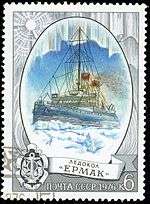Yermak (1898 icebreaker)
 Yermak on the Baltic Sea before 1917 | |
| History | |
|---|---|
| Name: | Yermak |
| Builder: |
list error: <br /> list (help) N. I. Yankovsky, R. I. Runeberg and others Armstrong Whitworth |
| Yard number: | 684 |
| Laid down: | 1897 |
| Launched: | 17 October 1898 |
| Completed: | 1899 |
| Acquired: | 1899 |
| Out of service: | 1963 |
| Fate: | Scrapped 1964 |
| General characteristics | |
| Displacement: | 8730 tons |
| Length: | 97.5 m |
| Beam: | 21.6 m |
| Draught: | 7.3 m |
| Ice class: | Icebreaker |
| Installed power: | 9000 hp |
| Propulsion: | 4 shaft, 8 VTE steam engines, 6 boilers |
| Speed: | 12 knots |
| Crew: | 102 |
Yermak (Russian: Ермак) (sometimes spelled Ermak) was a Russian and later Soviet Union icebreaker, the first polar icebreaker in the world, having a strengthened hull shaped to ride over and crush pack ice.
History


Yermak was built for the Imperial Russian Navy under the supervision of vice-admiral S. O. Makarov by the members of his commission, which included D. I. Mendeleev, engineers N. I. Yankovsky and R. I. Runeberg, admiral F. F. Wrangel, among others.[1] It was built in Newcastle upon Tyne at its Low Walker yard and launched in 1898. She was named after the famous Russian explorer of Siberia, Don Cossack ataman Yermak Timofeyevich.
She was commissioned on 17 October 1898. She arrived in Kronstadt on 4 March 1899 after breaking through ice and a formal reception was held to mark her arrival. Later in 1899 she reached 81°21'N north of Spitsbergen. She had been constructed to break through heavy ice (up to 2 m in thickness).
Yermak had been used in the winter of 1899–1900 to set up the first radio communication link in Russia between Kotka and Gogland (Suursaar) island (distance 47 km). In 1900 she came to the aid of the cruiser Gromoboi which had grounded in the Baltic.
Between 1899–1911 Yermak sailed in heavy ice conditions for more than 1000 days.
During World War I she assisted the Baltic Fleet during the Ice cruise when the fleet was evacuated from Helsinki to Kronstadt in February 1918.
During World War II the Yermak was mobilised again and took part in the evacuation of Hanko naval base. She was armed with two 102 mm, two 76 mm, four 45 mm and four machine guns.
Yermak served with different branches of the Russian and Soviet Navy and Merchant Marine up until 1964, becoming one of the longest-serving icebreakers in the world. An island in the Nordenskiöld Archipelago was named after her.
A monument to the icebreaker Yermak was unveiled in Murmansk In November 1965 – this included mosaic panels and the original anchor on the pedestal.
Another icebreaker with the name Yermak was built for the Soviet Union at the Wärtsilä Helsinki shipyard, Finland in 1974. Russia employs an icebreaker named Yermak in the Baltic Sea as late as 2010.[2]
See also
References
- ↑ На воду спущен первый в мире ледокол «Ермак»
- ↑ "Restrictions to Navigation" (PDF). Archived from the original (PDF) on 2010-02-18.
External links
| Wikimedia Commons has media related to Yermak (ship, 1899). |
